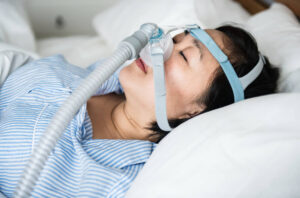Hiding your CPAP (Continuous Positive Airway Pressure) machine can make your bedroom feel more comfortable and less cluttered, especially if you’re conscious about the appearance of medical equipment in your personal space.
Here are several strategies to discreetly integrate your CPAP machine into your bedroom:
Nightstand with Storage
Find a nightstand or a small cabinet that can accommodate your CPAP machine inside. Look for furniture with holes at the back for cords to pass through, ensuring your machine stays hidden while being easily accessible.
Decorative Boxes
Place your CPAP machine inside a decorative box or a storage bin with holes cut out for the hose and power cord. This can be a stylish way to keep your machine out of sight while still maintaining functionality.
Under-Bed Storage
If your bed frame allows, you can store your CPAP machine under the bed in a storage container or drawer. Use a hose guide to comfortably extend the hose from under the bed to your mask.
Custom Covers
Use or create a custom cover that matches your bedroom decor. This cover can be placed over the CPAP machine during the day, making it blend in with the rest of your room.
Behind Curtains or Drapes
If your bed is near a window, you might be able to place the CPAP machine on a windowsill or a small shelf behind curtains or drapes, keeping it out of direct sight.
Shelving Units with Back Panels
Install a small shelving unit or bookcase that has back panels. The CPAP machine can be placed on one of the shelves, with the back panel hiding it from view. Ensure there’s enough ventilation for the machine to operate correctly.
Closet Placement
If you have a closet close to your bed, consider placing your CPAP machine on a shelf inside. You can run the hose under the door or through a small hole. This option requires a bit more setup but keeps the machine completely out of sight.
Wall-mounted Solutions
Some users opt for wall-mounted shelves or cabinets that can hide the CPAP machine while keeping it at a convenient height. Ensure the setup allows for easy access to the machine for cleaning and maintenance.
What should you take into account when trying to hide your CPAP machine?
When trying to hide your CPAP machine, it’s essential to consider several factors to ensure that the machine remains functional, accessible, and safe to use. Here are key considerations:
Ventilation and Overheating
CPAP machines need proper ventilation to function correctly and to prevent overheating. Ensure that wherever you place the machine, there is enough airflow around it. Avoid enclosed spaces that could trap heat.
Accessibility for Daily Use
You’ll need to access your CPAP machine every night, so it should be placed in a location that is easy to reach. Additionally, consider the ease of turning the machine on and off, adjusting settings, and connecting or disconnecting the hose.
Ease of Maintenance
Regular cleaning and maintenance are crucial for the health and longevity of your CPAP machine. Make sure you can easily remove the machine from its hiding spot for cleaning, replacing filters, or adding water to the humidifier (if applicable).
Noise Considerations
While modern CPAP machines are designed to be quiet, they still produce some noise. Think about how the machine’s location might affect its noise level. Placing it on a padded surface can help reduce vibration noise.
Cord and Hose Management
The power cord and air hose must reach from the machine to the power outlet and your bed, respectively. Consider how you’ll manage these cords to avoid tripping hazards, ensure they’re not too tightly stretched, and keep your bedroom looking tidy.
Humidity and Water Spillage
If your CPAP machine has a humidifier, be mindful of the potential for water spillage. Placing the machine at a lower height can prevent water from flowing back into the machine if the hose disconnects. Also, consider the surface you’re placing the machine on and whether it can be damaged by water.
Room Aesthetics
The primary goal of hiding your CPAP machine may be to maintain or improve the aesthetics of your room. Choose a hiding solution that complements your room’s decor and doesn’t stand out as an eyesore.
Emergency Access
In case of an emergency or power outage, you should be able to quickly access and disconnect your CPAP machine if needed. Ensure that your setup allows for this.
Compliance with Medical Needs
Your health and treatment efficacy should not be compromised by your CPAP machine’s location. Ensure that the machine’s placement does not negatively affect your therapy, such as by causing kinks in the hose that could restrict airflow.
By creatively integrating your CPAP machine into your bedroom, you can maintain the aesthetics of your space without compromising on your health and comfort.




